
The Stoibadeion (in Modern Greek: Stoivadeion) is a temple to Dionysus located on the Greek island of Delos.

The Stoibadeion (in Modern Greek: Stoivadeion) is a temple to Dionysus located on the Greek island of Delos.

The Stoibadeion contains a rectangular platform containing a statue of Dionysus, which was flanked by two actors impersonating Papposilenoi. These actors are now in the Delos Museum for protection. Two pillars, one on each side of the platform, each once supported a huge phallus, as a symbol of Dionysos. The southern pillar is decorated with relief scenes of a Dionysiac circle. Three sides of the southern pillar have relief representations: the central scene shows a cockerel whose head and neck are elongated into a phallus, on either side are groups containing Dionysus and a Maenad, with a small Silenus on one side and a figure of Pan on the other. The southern pillar bears an inscription that it was erected ca. 300 B.C. by a Delian named Carystios in celebration of a victorious theatrical performance he sponsored.
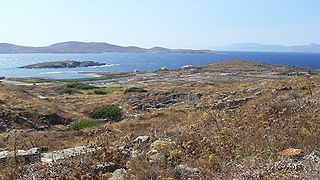
The island of Delos, near Mykonos, near the centre of the Cyclades archipelago, is one of the most important mythological, historical, and archaeological sites in Greece. The excavations in the island are among the most extensive in the Mediterranean; ongoing work takes place under the direction of the Ephorate of Antiquities of Cyclades, and many of the artifacts found are on display at the Archaeological Museum of Delos and the National Archaeological Museum of Athens.

A herma, commonly herm in English, is a sculpture with a head and perhaps a torso above a plain, usually squared lower section, on which male genitals may also be carved at the appropriate height. Hermae were so called either because the head of Hermes was most common or from their etymological connection with the Greek word ἕρματα, which originally had no reference to Hermes at all. The form originated in ancient Greece, and was adopted by the Romans, and revived at the Renaissance in the form of term figures and atlantes.
The djed, also djt is one of the more ancient and commonly found symbols in ancient Egyptian religion. It is a pillar-like symbol in Egyptian hieroglyphs representing stability. It is associated with the creator god Ptah and Osiris, the Egyptian god of the afterlife, the underworld, and the dead. It is commonly understood to represent his spine.

Sanchi is a Buddhist complex, famous for its Great Stupa, on a hilltop at Sanchi Town in Raisen District of the State of Madhya Pradesh, India. It is located, about 23 kilometers from Raisen town, district headquarter and 46 kilometres (29 mi) north-east of Bhopal, capital of Madhya Pradesh.

Abu Simbel is a historic site comprising two massive rock-cut temples in the village of Abu Simbel, Aswan Governorate, Upper Egypt, near the border with Sudan. It is situated on the western bank of Lake Nasser, about 230 km (140 mi) southwest of Aswan. The twin temples were originally carved out of the mountainside in the 13th century BC, during the 19th Dynasty reign of the Pharaoh Ramesses II. Their huge external rock relief figures of Ramesses II have become iconic. His wife, Nefertari, and children can be seen in smaller figures by his feet. Sculptures inside the Great Temple commemorate Ramesses II's heroic leadership at the Battle of Kadesh.
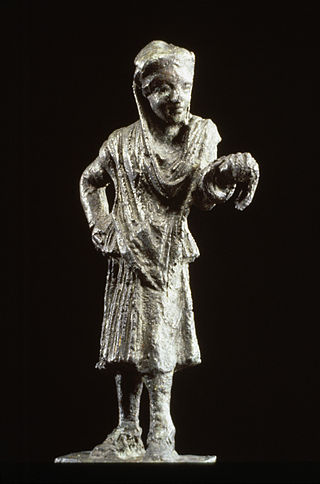
Ancient Greek theatre was a theatrical culture that flourished in ancient Greece from 700 BC. The city-state of Athens, which became a significant cultural, political, and religious place during this period, was its centre, where the theatre was institutionalised as part of a festival called the Dionysia, which honoured the god Dionysus. Tragedy, comedy, and the satyr play were the three dramatic genres to emerge there. Athens exported the festival to its numerous colonies. Modern Western theatre comes, in large measure, from the theatre of ancient Greece, from which it borrows technical terminology, classification into genres, and many of its themes, stock characters, and plot elements.

Greek temples were structures built to house deity statues within Greek sanctuaries in ancient Greek religion. The temple interiors did not serve as meeting places, since the sacrifices and rituals dedicated to the respective ouranic deity took place outside them, within the wider precinct of the sanctuary, which might be large. Temples were frequently used to store votive offerings. They are the most important and most widespread building type in Greek architecture. In the Hellenistic kingdoms of Southwest Asia and of North Africa, buildings erected to fulfill the functions of a temple often continued to follow the local traditions. Even where a Greek influence is visible, such structures are not normally considered as Greek temples. This applies, for example, to the Graeco-Parthian and Bactrian temples, or to the Ptolemaic examples, which follow Egyptian tradition. Most Greek temples were oriented astronomically.

The Chennakesava Temple, also referred to as Chennakeshava Temple and Keshava Temple, is a Vaishnava Hindu temple on the banks of River Kaveri at Somanathapura, Karnataka, India. The temple was consecrated in 1258 CE by Somanatha Dandanayaka, a general of the Hoysala King Narasimha III. It is located 38 kilometres (24 mi) east of Mysuru city.

A theater, theatre or playhouse, is a structure where theatrical works, performing arts and musical concerts are presented. The theater building serves to define the performance and audience spaces. The facility usually is organized to provide support areas for performers, the technical crew and the audience members, as well as the stage where the performance takes place.

The Siphnian Treasury was a building at the Ancient Greek cult centre of Delphi, erected to host the offerings of the polis, or city-state, of Siphnos. It was one of a number of treasuries lining the "Sacred Way", the processional route through the Sanctuary of Apollo, erected to win the favor of the gods and increase the prestige of the donor polis. It was one of the earlier surviving buildings of this type, and its date remains a matter for debate, with the most plausible date being around 525 BC. Until recently it was often confused or conflated with the neighbouring Cnidian Treasury, a similar but less elaborate building, as the remains of the two had become mixed together and earlier theoretical reconstructions used parts of both.
Amykles is a village in Laconia, southern Greece. It lies in the plain by the Eurotas river, 6 km south of Sparta, east of the Taygetus mountains, along the Greek National Road 39 from Sparta to Gytheio. It was named after the ancient town Amyclae, the ruins of which are situated 2 km northeast of the village.
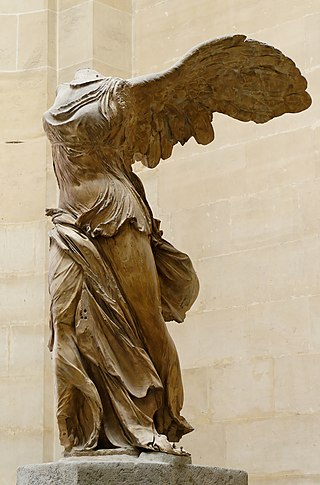
Hellenistic art is the art of the Hellenistic period generally taken to begin with the death of Alexander the Great in 323 BCE and end with the conquest of the Greek world by the Romans, a process well underway by 146 BCE, when the Greek mainland was taken, and essentially ending in 30 BCE with the conquest of Ptolemaic Egypt following the Battle of Actium. A number of the best-known works of Greek sculpture belong to this period, including Laocoön and His Sons, Venus de Milo, and the Winged Victory of Samothrace. It follows the period of Classical Greek art, while the succeeding Greco-Roman art was very largely a continuation of Hellenistic trends.

The Temple of Ptah is a shrine located within the large Precinct of Amun-Re at Karnak, in Luxor, Egypt. It lies to the north of the main Amun temple, just within the boundary wall. The building was erected by the Pharaoh Thutmose III on the site of an earlier Middle Kingdom temple. The edifice was later enlarged by the Ptolemaic Kingdom.
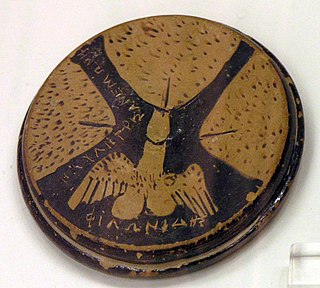
A phallus is a penis, an object that resembles a penis, or a mimetic image of an erect penis. In art history a figure with an erect penis is described as ithyphallic.
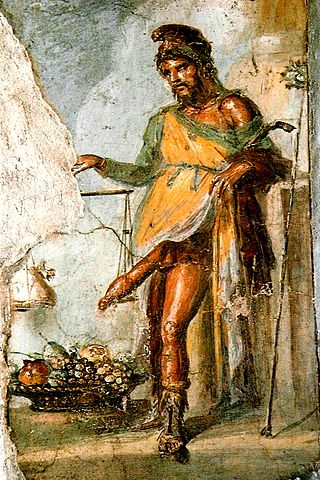
In Greek mythology, Priapus is a minor rustic fertility god, protector of livestock, fruit plants, gardens and male genitalia. Priapus is marked by his oversized, permanent erection, which gave rise to the medical term priapism. He became a popular figure in Roman erotic art and Latin literature, and is the subject of the often humorously obscene collection of verse called the Priapeia.
Dionysiakos is a form of Greek dance and customs from ancient Greece. Dionysiakos and its forms revived today in many areas of Greece like Peloponnese, central Greece and Crete with the best-known the Phallus festival in the area of Tyrnavos, Larissa.

Phallic architecture consciously or unconsciously creates a symbolic representation of the human penis. Buildings intentionally or unintentionally resembling the human penis are a source of amusement to locals and tourists in various places around the world. Deliberate phallic imagery is found in ancient cultures and in the links to ancient cultures found in traditional artifacts.

Parthian art was Iranian art made during the Parthian Empire from 247 BC to 224 AD, based in the Near East. It has a mixture of Persian and Hellenistic influences. For some time after the period of the Parthian Empire, art in its styles continued for some time. A typical feature of Parthian art is the frontality of the people shown. Even in narrative representations, the actors do not look at the object of their action, but at the viewer. These are features that anticipate the art of medieval Europe and Byzantium.

The Monument of Aemilius Paullus was erected in the Sanctuary of Apollo at Delphi shortly after 167 BCE in order to commemorate the Roman victory over King Perseus of Macedon at the Battle of Pydna. The incomplete pillar was intended as a base for a portrait of King Perseus. It was originally created to establish the Macedonian presence in Delphi, and to remind the Delphians of the tradition of friendship existing between them and the royal family. However, the monument was taken over by Aemilius Paullus to celebrate himself and Rome's victory noting that, "it was only proper that the conquered should give way to the victors." The Monument of Aemilius Paullus stood in front of the Temple of Apollo along with two other commemorative pillars to Eumenes II of Pergamon and Prusias II of Bithynia. However, this pillar dominates over the other two. The completed monument had a bronze equestrian statue that sat on top of a rectangular pillar over 9 meters high. Although the bronze statue that originally sat atop the pillar no longer remains, the cuttings in the plinth show that the horse would have been in a rearing position. An inscription at the base of the pillar survived, L(ucius) Aimilius L(uci) f(ilius) inperator de rege Perse / Macedonibusque cepet, which translated, reads, "Lucius Aemelius, son of Lucius, Imperator, took it from King Perseus and the Macedonians."

Xanthos, also called Xanthus, was a chief city state of the Lycians, an indigenous people of southwestern Anatolia. Many of the tombs at Xanthos are pillar tombs, formed of a stone burial chamber on top of a large stone pillar. The body would be placed in the top of the stone structure, elevating it above the landscape. The tombs are for men who ruled in a Lycian dynasty from the mid-6th century to the mid-4th century BCE and help to show the continuity of their power in the region. Not only do the tombs serve as a form of monumentalization to preserve the memory of the rulers, but they also reveal the adoption of Greek style of decoration.